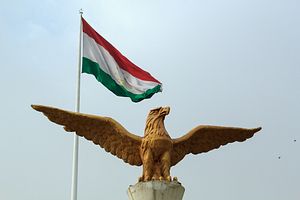A few days after Tajikistani lawmakers bestowed President Emomali Rahmon with the title of “Leader of the Nation” – and thereby granting him lifetime immunity from any potential prosecution for his work in office – the government in Dushanbe continued stamping out any political opposition that may remain. On Monday, the country’s interior minister continued linking a September quasi-coup to the government’s erstwhile mainstream Islamic opposition – and to the putative “terrorists” within the organization.
According to Interior Minister Ramazon Rahimzoda, the Islamic Renaissance Party of Tajikistan (IRPT) financed the September attacks, which left nearly two dozen dead. Rahimzoda added that those behind the attacks – including former Deputy Defense Minister Abduhalim Nazarzoda – were members of an unnamed terrorist group. This isn’t the first time a Tajik official has claimed the IRPT helped push terrorism within Tajikistan. Rahmon previously tied the IRPT to the “terrorists with evil consciences” behind the September assaults. The deputy defense minister’s comments help confirm that Dushanbe’s push against the IRPT, which was Central Asia’s lone mainstream Islamic party, is not over.
The government’s campaign against the IRPT has left the group in tatters. Its leadership and membership has been decimated through exile and arrest. The IRPT, whose ties to “terrorist organizations” remain specious and politically expedient for Dushanbe, was declared an “extremist and terrorist organization” by a Supreme Court ruling in September. The Tajik government, undoubtedly rattled by Nazarzoda’s mutiny, has accelerated its moves against the IRPT, with Rahimzoda making sure making sure the linking of the IRPT and “terrorism” continues apace.
But Rahimzoda didn’t stop the putative Islamist threat with claims solely against the opposition. He added that some 600 Tajik nationals were fighting in Iraq and Syria, with an additional 50 nationals having already returned home at the behest of authorities in Dushanbe. The number would appear to be the largest single estimate of Central Asian fighters yet lofted by a regional official, and fits within the burgeoning narrative of Islamist, and especially ISIS, threats to the region.
The number also nearly doubles an estimate from The Soufan Group, which had recently written that fighters from “Russian and Central Asia have shown a significant rise; some estimates suggest a near 300% increase in known fighters since June 2014.”
As with previous estimates, however, there seems little credence to The Soufan Group’s Central Asia numbers, especially in terms of the rate of growth. To wit, The Soufan Group cited official estimates from Kazakhstan and Tajikistan – the latter of which was a remarkably specific 386 fighters. (The group also cited “non-official” estimates from Uzbekistan, Turkmenistan, and Kyrgyzstan, but did not specify the sources for these “non-official” estimates.) As illustrated time and again, taking governmental estimates on Central Asian fighter flow as firm fact comes with myriad obstacles – all the more when the government is trying to tie the IRPT to “terrorism,” and spin both the party and foreign fighters as threats to the country’s “savior.”
































